Geochemical Characteristics and Ecological Risk Assessment of Heavy Metals in Surface Soil of Gaomi City
Abstract
:1. Introduction
2. Research Background
3. Samples and Methods
3.1. Sample Collection
3.2. Samples Preparation and Testing
3.3. Data Processing and Mapping
4. Results-Geochemical Characteristics of HMs in Topsoil
4.1. GCB of HMs in Topsoil
4.1.1. GCB of Heavy Metal Elements in the Topsoil of the Whole Region
4.1.2. GCB of Heavy Metal Elements in Surface Soil of Different Geological Unit Areas
4.1.3. GCB of Heavy Metal Elements in the Surface Soil of Different Types of Land Use Areas
4.2. Homologous-Cluster Analysis of Heavy Metal Elements
4.2.1. Cluster Analysis
4.2.2. Homologous Analysis
| Elements | Main Causes | References |
|---|---|---|
| Cd | Smelting of non-ferrous metals, disposal of cadmium-containing wastes. | [43,44,45,46] |
| Cu | Smelting emissions soot, industrial coal, automobile exhaust. | |
| Pb | Gas from gasoline combustion, lead paint, smelting, casting. | |
| Zn | Smelting, waste incineration, rubber tire wear. | |
| Ni | Smelting, roasting, automobile exhaust. | |
| Cr | Metal processing, electroplating, tanning, coal burning, oil burning. | |
| Hg | Coal-fired power plants, mining and processing of related mineral materials. | |
| As | Industrial production, use of arsenic-containing pesticides, coal burning. |
5. Ecological Risk Assessment
5.1. Ecological Risk Assessment Methods
5.2. Ecological Risk Assessment Results
6. Conclusions
- (1)
- Compared with the GCB of Weifang, As is higher, Pb is similar, and others are lower. Compared with the GCB Shandong Province, Pb, As, and Cr are similar, whereas others are lower. The GCB of different geological units and land use types are different, indicating that the distribution of heavy metal elements is affected by geological background and human activities.
- (2)
- The homology cluster analysis showed that the Cd, Cu, Pb, and Zn in the topsoil had similar origin or homology, which were mainly affected by human activities. Ni and Cr have similar origin or homology, and are affected by geological background, geomorphologic form and human activities. Hg and As had similar origin or homology, and the high value area showed radial distribution, which may be related to industrial and mining enterprises.
- (3)
- According to the evaluation of ecological risk based on soil risk management and control standards, the study area is dominated by riskless soils, but there are also some soils with high risks. The average potential ecological risk coefficient of Hg reached moderate pollution degree. Based on an evaluation of potential ecological risk index, the surface soil in the study area is found to contain light pollution, with an area of more than 90%. Meanwhile, there are also moderate pollution, strong pollution, and very strong pollution, among which strong pollution and very strong pollution areas are small, displaying a point-source distribution located in densely populated areas.
Author Contributions
Funding
Institutional Review Board Statement
Informed Consent Statement
Data Availability Statement
Conflicts of Interest
References
- Wu, Q.; Hu, W.; Wang, H.; Liu, P.; Wang, X.; Huang, B. Spatial distribution, ecological risk and sources of heavy metals in soils from a typical economic development area, Southeastern China. Sci. Total Environ. 2021, 780, 146557. [Google Scholar] [CrossRef]
- Lopéz, Y.P.; da Fonseca Breda, F.A.; Lima, E.S.A.; de Souza, C.d.C.B.; González, J.M.F.; do Amaral Sobrinho, N.M.B. Variability factors of heavy metals in soils and transfer to pasture plants of Mayabeque in Cuba. Environ. Monit. Assess. 2021, 193, 1–17. [Google Scholar] [CrossRef] [PubMed]
- Ali, H.; Khan, E.; Ilahi, I. Environmental Chemistry and Ecotoxicology of Hazardous Heavy Metals: Environmental Persistence, Toxicity, and Bioaccumulation. J. Chem. 2019, 2019, 6730305. [Google Scholar] [CrossRef] [Green Version]
- Jiao, W.; Chen, W.; Chang, A.C.; Page, A.L. Environmental risks of trace elements associated with long-term phosphate fertilizers applications: A review. Environ. Pollut. 2012, 168, 44–53. [Google Scholar] [CrossRef]
- Wang, T.; Tan, C.; Cao, X.; Da, O.; Nie, J.; Wang, B.; He, Q.; Liang, Y. Effects of long-term fertilization on the accumulation and availability of heavy metals in soil. J. Agro-Environ. Sci. 2017, 36, 257–263. [Google Scholar] [CrossRef]
- Pan, Q.U.; Yang, J.; Teng, Y.; Wang, J. Bioavailability of heavy metal in different chemical fertilizers under simulated acid rain. J. Beijing Norm. Univ. (Nat. Sci.) 2016, 52, 597–602. [Google Scholar] [CrossRef]
- Smith, S.R. A critical review of the bioavailability and impacts of heavy metals in municipal solid waste composts compared to sewage sludge. Environ. Int. 2009, 35, 142–156. [Google Scholar] [CrossRef] [PubMed]
- Yang, Q.; Li, Z.; Lu, X.; Duan, Q.; Huang, L.; Bi, J. A review of soil heavy metal pollution from industrial and agricultural regions in China: Pollution and risk assessment. Sci. Total Environ. 2018, 642, 690–700. [Google Scholar] [CrossRef] [PubMed]
- Shi, J.; Liu, X.; Yu, C.; Zhu, H.; Zhao, K.; Wu, J.; Xu, J. Spatial variability and risk evaluation of soil heavy metals in taihu lake region of north Zhejiang province. Acta Pedol. Sin. 2007, 44, 824–830. [Google Scholar] [CrossRef]
- Han, W.; Wang, C.; Peng, M.; Wang, Q.; Yang, F.; Xu, R. Characteristics and Origins of Heavy Metals in Soil and Crops in Mountain Area of Southern Sichuan. Environ. Sci. 2021, 42, 2480–2489. [Google Scholar] [CrossRef]
- Chen, W.; Li, Q.; Wang, Z.; Sun, Z. Spatial Distribution Characteristics and Pollution Evaluation of Heavy Metals in Arable Land Soil of China. Environ. Sci. 2020, 41, 2822–2833. [Google Scholar] [CrossRef]
- Tedoldi, D.; Chebbo, G.; Pierlot, D.; Branchu, P.; Kovacs, Y.; Gromaire, M.C. Spatial distribution of heavy metals in the surface soil of source-control stormwater infiltration devices—Inter-site comparison. Sci. Total Environ. 2017, 579, 881–892. [Google Scholar] [CrossRef]
- Esmaeili, A.; Moore, F.; Keshavarzi, B.; Jaafarzadeh, N.; Kermani, M. A geochemical survey of heavy metals in agricultural and background soils of the Isfahan industrial zone, Iran. Catena 2014, 121, 88–98. [Google Scholar] [CrossRef]
- Lehmann, A.; Stahr, K. Nature and significance of anthropogenic urban soils. J. Soils Sediments 2007, 7, 247–260. [Google Scholar] [CrossRef]
- Qu, F.; Wen, L.; Fan, C.; Liu, G.; Qin, S. Heavy metal contents in soils developed from different parent materials and their ecological risk assessment. Acta Mineral. Sin. 2020, 40, 677–684. [Google Scholar] [CrossRef]
- Facchinelli, A.; Sacchi, E.; Mallen, L. Multivariate statistical and GIS-based approach to identify heavy metal sources in soils. Environ. Pollut. 2001, 114, 313–324. [Google Scholar] [CrossRef]
- Amaya, F.-U.; Cristina, L.-M.; Enrique, R.; Luisa, F.-M.M. Source identification of heavy metals in pastureland by multivariate analysis in NW Spain. J. Hazard. Mater. 2009, 165, 1008–1015. [Google Scholar] [CrossRef]
- Almasoud, F.I.; Usman, A.R.; Al-Farraj, A.S. Heavy metals in the soils of the Arabian Gulf coast affected by industrial activities: Analysis and assessment using enrichment factor and multivariate analysis. Arab. J. Geosci. 2015, 8, 1691–1703. [Google Scholar] [CrossRef]
- Jallad, K.N. Heavy metal exposure from ingesting rice and its related potential hazardous health risks to humans. Environ. Sci. Pollut. Res. 2015, 22, 15449–15458. [Google Scholar] [CrossRef]
- Kinuthia, K.G.; Veronica, N.; Dunstone, B.; Reuben, L.; Agnes, W.; Luna, K. Levels of heavy metals in wastewater and soil samples from open drainage channels in Nairobi, Kenya: Community health implication. Sci. Rep. 2020, 10, 8434. [Google Scholar]
- Albanese, S.; Vivo, B.D.; Lima, A.; Cicchella, D. Geochemical background and baseline values of toxic elements in stream sediments of Campania region (Italy). J. Geochem. Explor. 2007, 93, 21–34. [Google Scholar] [CrossRef]
- Wang, C.; Pang, X.; Wang, H.; Zeng, X.; Hu, X.; Zhen, W. High-F groundwater in Gaomi city-its genetic study. Earth Environ. 2011, 39, 355–362. [Google Scholar] [CrossRef]
- Gao, Z.J.; Zhu, Z.H.; Liu, X.D.; Yan-Lan, X.U. The Formation and Model of High Fluoride Groundwater and In-Situ Dispelling Fluoride Assumption in Gaomi City of Shandong Province. J. Groundw. Sci. Eng. 2014, 21, 50–58. [Google Scholar] [CrossRef]
- GB 15618-2018. Environmental Quality Standard for Soils: Risk Control Standard of Soil Pollution in Agricultural Land; Ministry of Ecology and Environment: Beijing, China, 2018. [Google Scholar]
- GB 36600-2018. Environmental Quality Standard for Soils: Risk Control Standard of Soil Pollution in Construction Land; Ministry of Ecology and Environment: Beijing, China, 2018. [Google Scholar]
- You, X.; Xing, T.; Yin, M.; Mei, X. Geological Characteristics and Genesis Analysis of Barite Deposit in Huashan Mine of Gaomi City. Shandong Land Resour. 2016, 32, 26–30. [Google Scholar]
- Chen, Q.; Hao, D.; Gao, Z.; Shi, M.; Wang, M.; Feng, J.; Deng, Q.; Xia, L.; Zhang, C.; Yu, Y. The Enrichment Process of Groundwater Fluorine in Sea Water Intrusion Area of Gaomi City, China. Ground Water 2020, 58, 882–891. [Google Scholar] [CrossRef]
- Xu, J.; Zhang, T.; Xu, H.; Zhang, Z.; Qi, X.; Ji, W. Study on Coastal Loess in the Laizhou Bay. Adv. Mar. Sci. 2019, 37, 43–54. [Google Scholar]
- Gao, M. Particle Size Distribution Characteristics of Sediments in Holocene Linyi Formation in Dawenkou Basin in Shandong Province. Shandong Land Resour. 2018, 34, 8–13. [Google Scholar]
- Liu, Y.; Kuang, H.; Peng, N.; Xu, H.; Liu, Y. Sedimentary facies of dinosaur trackways and bonebeds in the Cretaceous Jiaolai Basin, eastern Shandong, China, and their paleogeographical implications. Earth Sci. Front. 2011, 18, 9–24. [Google Scholar]
- Fu, Z.; Li, Z. Characteristics and high yield and high quality cultivation techniques of leek in dajingou Town, Gaomi City. Chin. Veg. 2019, 5, 98–100. [Google Scholar]
- Meng, X. Research on the Development of Gaomi City Brand Agriculture. Master’s Thesis, Shandong Agricultural University, Tai’an, China, 2014. [Google Scholar]
- DZ/T 0295-2016. Specification for Geochemical Evaluation of Land Quality; Ministry of Ecology and Environment: Beijing, China, 2016. [Google Scholar]
- Xi, X.; Hou, Q. Big data based studies of the variation features of Chinese soil. Geophys. Geochem. Explor. 2021, 45, 1–14. [Google Scholar] [CrossRef]
- DD2005-03. Technical Requirements for Analysis of Ecological Geochemical Evaluation Samples; China Geological Survey: Beijing, China, 2005. [Google Scholar]
- Yuan, G.L.; Sun, T.H.; Han, P.; Li, J.; Lang, X.X. Source identification and ecological risk assessment of heavy metals in topsoil using environmental geochemical mapping: Typical urban renewal area in Beijing, China. J. Geochem. Explor. 2014, 136, 40–47. [Google Scholar] [CrossRef]
- Pang, X.; Dai, J.; Chen, L.; Liu, H.; Yu, C. Soil Geochemical Background Value of 17 Cities in Shandong Province. Shandong Land Resour. 2019, 35, 46–56. [Google Scholar]
- Pang, X.; Dai, J.; Hu, X.; Song, Z. Background Values of Soil Geochemistry in Shandong Province. Shandong Land Resour. 2018, 34, 39–43. [Google Scholar]
- Chiroma, T.M.; Ebewele, R.O.; Hymore, F.K. Comparative assessment of heavy metal levels in soil, vegetables and urban grey water used for irrigation in Yola and Kano. Int. Refereed J. Eng. Sci. 2014, 3, 1–9. [Google Scholar]
- Xu, Y.L.; Feng, G.L.; Jiang, X.; Liu, N.; Yang, Y.L. Distribution characteristics of heavy metals in soil and its influence on greening plants in a main road of Lanzhou City, Northwest China. J. Appl. Ecol. 2020, 31, 1341–1348. [Google Scholar]
- Yang, Y.; Liu, A.; Chao, L.; Shan, Y.; Wu, N.; Chen, H.; Wang, M. Spatial Distribution of Soil Heavy Metals of Opencut Coal Mining in Inner Mongolia Xilingol Typical Steppe. Ecol. Environ. Sci. 2016, 25, 885–892. [Google Scholar] [CrossRef]
- Han, Y.; Du, P.; Cao, J.; Posmentier , E.S. Multivariate analysis of heavy metal contamination in urban dusts of Xi’an, Central China. Sci. Total Environ. 2005, 355, 176–186. [Google Scholar] [CrossRef]
- Lu, H.; Xiao, G.; Liu, Q.; Peng, X. Advances in soil Cd pollution and solution measures. J. South. Agric. 2014, 45, 1986–1993. [Google Scholar]
- Yan, X.; Zheng, H.; Zhao, X.; Yu, Y.; Zhong, J. Source identification and health risk assessment of soil heavy metal in the estuary of Northern Liaodong Bay, China. Acta Sci. Circumstantiae 2020, 40, 3028–3039. [Google Scholar] [CrossRef]
- Huang, Z.; Guan, D.; Wang, G. Heavy metal contents of mangrove surface soils affected by the social and economic development in Hainan Island. Mar. Environ. Sci. 2020, 39, 831–837. [Google Scholar] [CrossRef]
- Zhang, H.; Yin, A.; Yang, X.; Fan, M.; Shao, S.; Wu, J.; Wu, P.; Zhang, M.; Gao, C. Use of machine-learning and receptor models for prediction and source apportionment of heavy metals in coastal reclaimed soils. Ecol. Indic. 2021, 122, 107233. [Google Scholar] [CrossRef]
- Lars, H. An ecological risk index for aquatic pollution control.a sedimentological approach. Pergamon 1980, 14, 975–1001. [Google Scholar] [CrossRef]
- Xu, Z.; Ni, S.; Tuo, X.; Zhang, C. Calculation of Heavy Metals’Toxicity Coefficient in the Evaluation of Potential Ecological Risk Index. Environ. Sci. Technol. 2008, 31, 112–115. [Google Scholar] [CrossRef]
- Kumar, P.K.; Sumanta, N.; Manash, G.; Kumar, R.A.; Rajnarayan, S. Sources evaluation, ecological and health risk assessment of potential toxic metals (PTMs) in surface soils of an industrial area, India. Environ. Geochem. Health 2020, 42, 1–22. [Google Scholar]
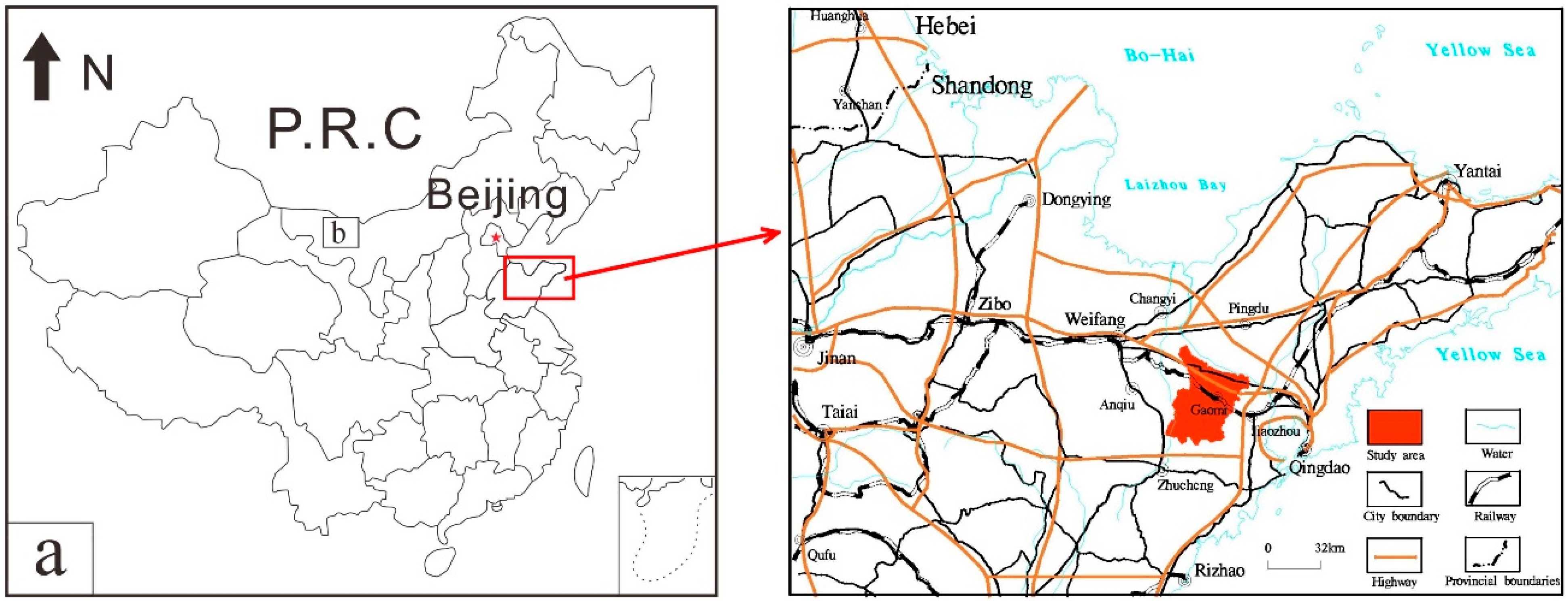
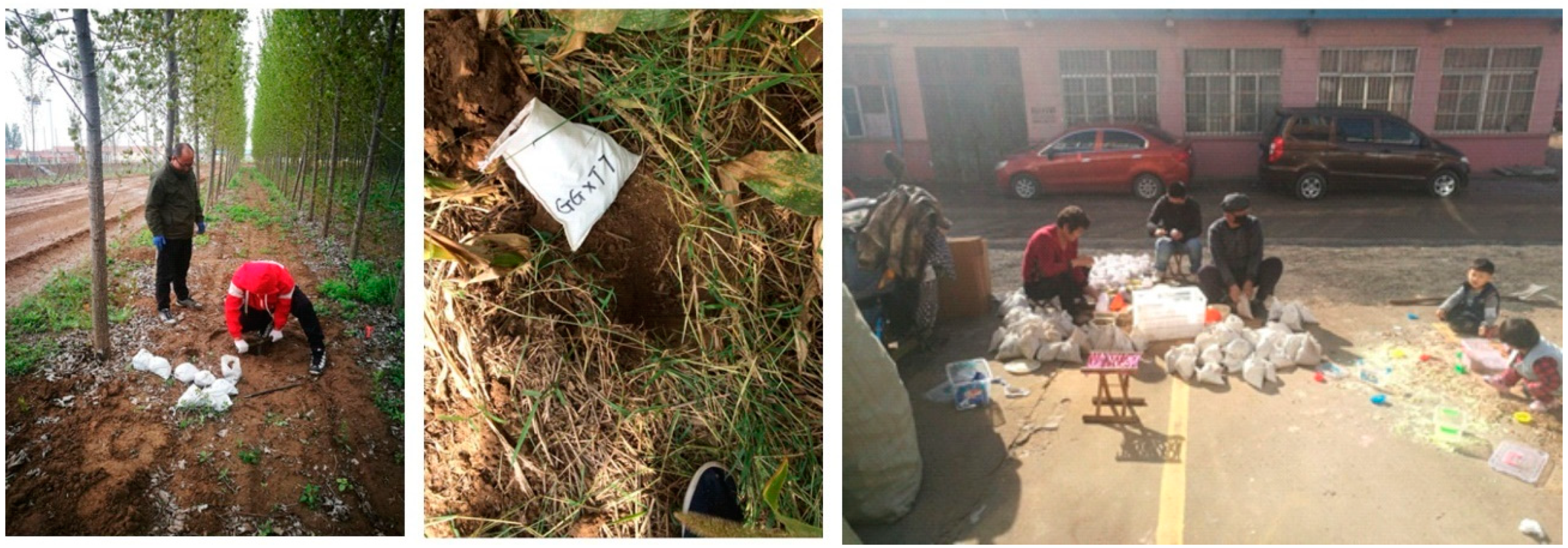
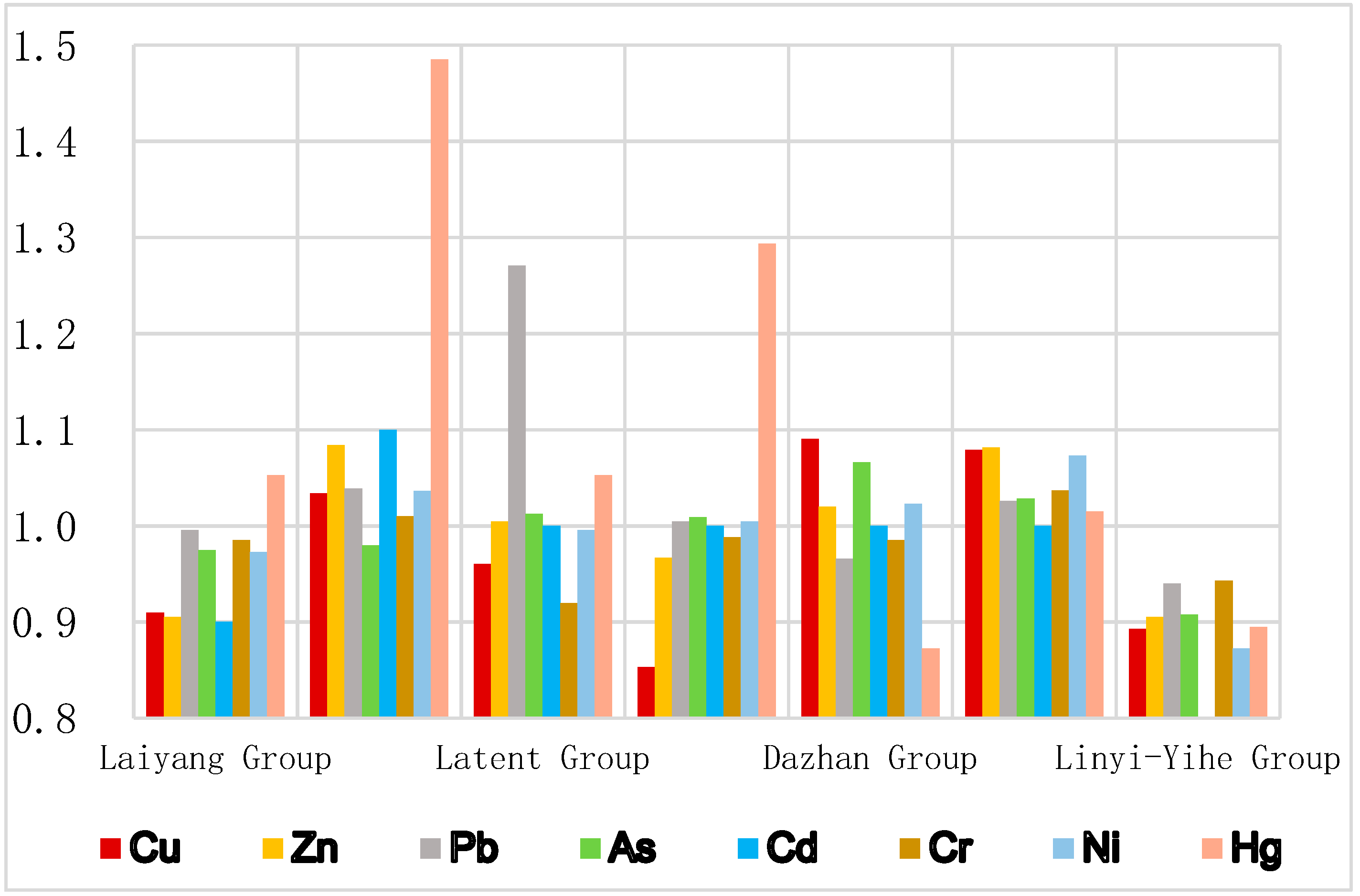

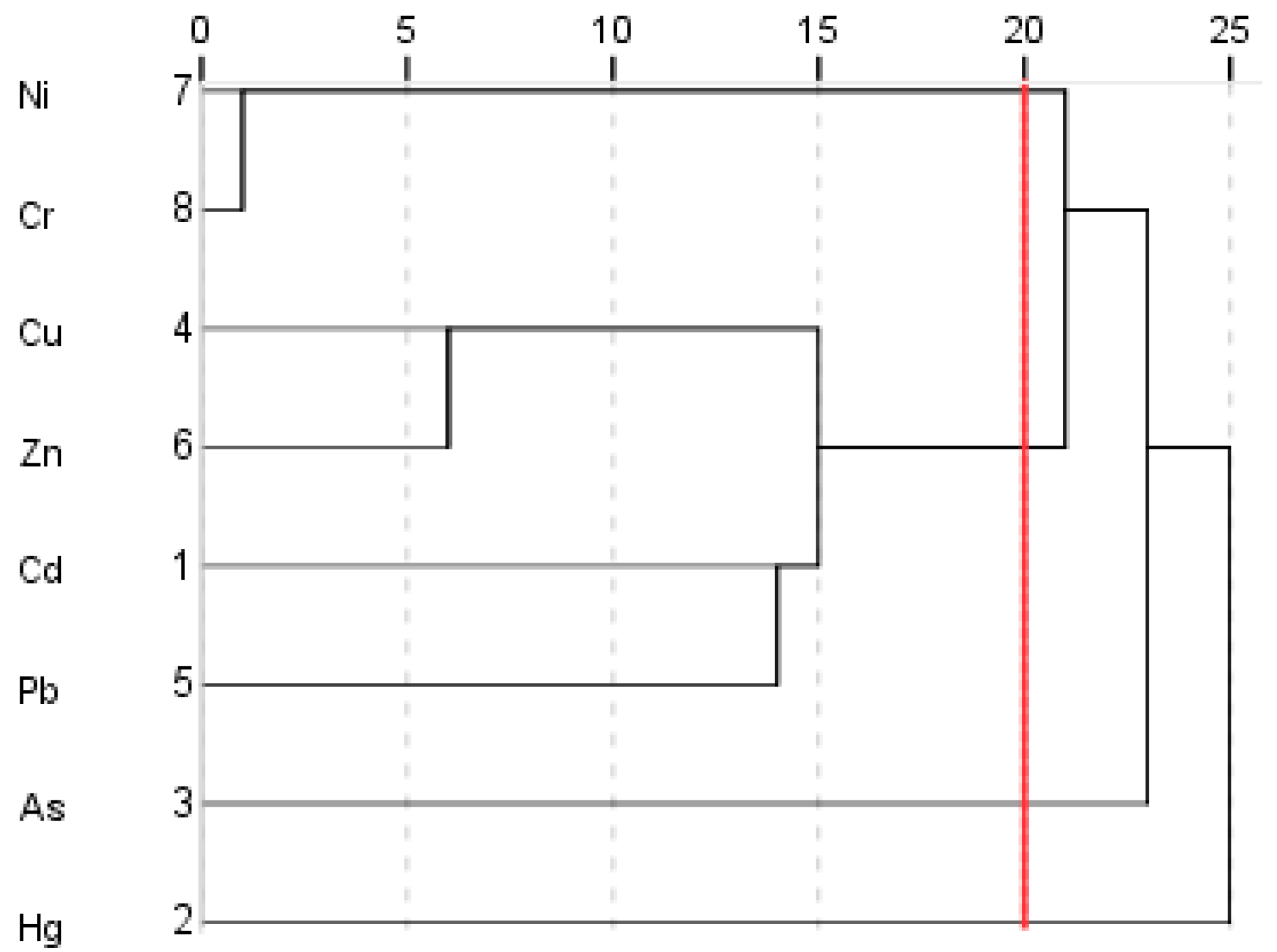
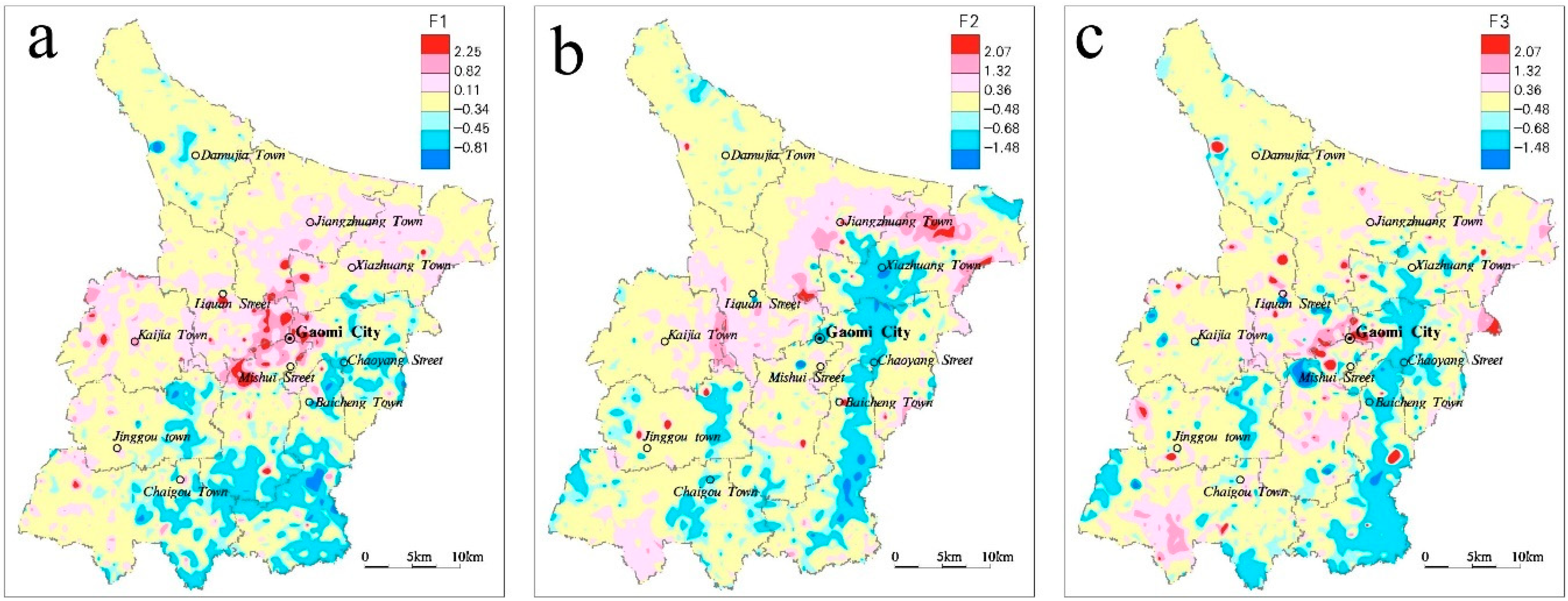

| Element | Median/10−6 | Variation Coefficient | Variation Range/10−6 | GCB/10−6 | GCBRs | |||
|---|---|---|---|---|---|---|---|---|
| Gaomi | Weifang | Shandong | Gaomi/Weifang | Gaomi/Shandong | ||||
| Cu | 17.4 | 0.98 | 7.1–28.3 | 17.7 | 21.2 | 22.6 | 0.83 | 0.78 |
| Zn | 44.3 | 0.68 | 24.3–66.3 | 45.3 | 58.5 | 63.3 | 0.77 | 0.72 |
| Pb | 23.3 | 0.23 | 16.6–30 | 23.3 | 22.9 | 23.6 | 1.02 | 0.99 |
| As | 8.79 | 0.49 | 4.72–12.79 | 8.75 | 7.8 | 8.6 | 1.12 | 1.02 |
| Cd | 0.10 | 0.78 | 0.05–0.15 | 0.10 | 0.114 | 0.132 | 0.88 | 0.76 |
| Cr | 58.9 | 0.25 | 40.3–79 | 59.6 | 65.3 | 62 | 0.91 | 0.96 |
| Ni | 21.7 | 0.34 | 12.1–31.7 | 21.9 | 26.9 | 27.1 | 0.81 | 0.81 |
| Hg | 0.0252 | 4.13 | 0.01–0.05 | 0.0266 | 0.032 | 0.031 | 0.83 | 0.86 |
| Organization/Country | Cu | Zn | Pb | As | Cd | Cr | Ni | Hg |
|---|---|---|---|---|---|---|---|---|
| WHO [20,39] | 100 | 300 | 100 | 20 | 3 | 100 | 50 | −8 |
| China [24,25] | 200 | 300 | 240 | 20 | 0.8 | 350 | 190 | 1 |
| Median | 17.4 | 44.3 | 23.3 | 8.79 | 0.10 | 58.9 | 21.7 | 0.0252 |
| Geological Unit | Laiyang Group | Qingshan Group | Latent Volcanic Rocks | Dasheng Group | Dazhan Formation | Heituhu Formation | Linyi-Yihe Formation |
|---|---|---|---|---|---|---|---|
| Area (km2) | 423.6 | 11.8 | 8.50 | 21.8 | 185.0 | 647.0 | 227.9 |
| Percentage (%) | 27.76 | 0.78 | 0.56 | 1.43 | 12.13 | 42.41 | 14.94 |
| Geological Unit | Elements | ||||||||
|---|---|---|---|---|---|---|---|---|---|
| Cu | Zn | Pb | As | Cd | Cr | Ni | Hg | ||
| Laiyang Group | GCB/10−6 | 16.10 | 41.00 | 23.20 | 8.53 | 0.09 | 58.70 | 21.30 | 0.028 |
| GCBRs | 0.91 | 0.91 | 1.00 | 0.97 | 0.90 | 0.98 | 0.97 | 1.05 | |
| Qingshan Group | GCB/10−6 | 18.30 | 49.10 | 24.20 | 8.57 | 0.11 | 60.20 | 22.70 | 0.040 |
| GCBRs | 1.03 | 1.08 | 1.04 | 0.98 | 1.10 | 1.01 | 1.04 | 1.48 | |
| Latent volcanic rocks | GCB/10−6 | 17.00 | 45.50 | 29.60 | 8.86 | 0.10 | 54.80 | 21.80 | 0.028 |
| GCBRs | 0.96 | 1.00 | 1.27 | 1.01 | 1.00 | 0.92 | 1.00 | 1.05 | |
| Dasheng Group | GCB/10−6 | 15.10 | 43.80 | 23.40 | 8.83 | 0.10 | 58.90 | 22.00 | 0.034 |
| GCBRs | 0.85 | 0.97 | 1.00 | 1.01 | 1.00 | 0.99 | 1.00 | 1.29 | |
| Dazhan Formation | GCB/10−6 | 19.30 | 46.20 | 22.50 | 9.33 | 0.10 | 58.70 | 22.40 | 0.023 |
| GCBRs | 1.09 | 1.02 | 0.97 | 1.07 | 1.00 | 0.98 | 1.02 | 0.87 | |
| Heituhu Formation | GCB/10−6 | 19.10 | 49.00 | 23.90 | 9.00 | 0.10 | 61.80 | 23.50 | 0.027 |
| GCBRs | 1.08 | 1.08 | 1.03 | 1.03 | 1.00 | 1.04 | 1.07 | 1.02 | |
| Linyi-Yihe Formation | GCB/10−6 | 15.80 | 41.00 | 21.90 | 7.94 | 0.08 | 56.20 | 19.10 | 0.024 |
| GCBRs | 0.89 | 0.91 | 0.94 | 0.91 | 0.80 | 0.94 | 0.87 | 0.89 | |
| Land Use Types | Elements | ||||||||
|---|---|---|---|---|---|---|---|---|---|
| Cu | Zn | Pb | As | Cd | Cr | Ni | Hg | ||
| cultivated land | GCB/10−6 | 17.8 | 45.3 | 23.4 | 8.93 | 0.1 | 59.9 | 22.1 | 0.0268 |
| GCBRs | 1.01 | 1.00 | 1.00 | 1.02 | 1.00 | 1.01 | 1.01 | 1.01 | |
| Garden | GCB/10−6 | 21.9 | 47.8 | 23.5 | 8.94 | 0.11 | 58.5 | 21 | 0.0313 |
| GCBRs | 1.24 | 1.06 | 1.01 | 1.02 | 1.10 | 0.98 | 0.96 | 1.18 | |
| Woodland | GCB/10−6 | 16 | 42.1 | 22.2 | 8.06 | 0.09 | 58 | 21 | 0.0258 |
| GCBRs | 0.90 | 0.93 | 0.95 | 0.92 | 0.90 | 0.97 | 0.96 | 0.97 | |
| Grass land | GCB/10−6 | 15.6 | 42.6 | 22.1 | 7.17 | 0.09 | 61 | 21.5 | 0.0197 |
| GCBRs | 0.88 | 0.94 | 0.95 | 0.82 | 0.90 | 1.02 | 0.98 | 0.74 | |
| Transportation land | GCB/10−6 | 20.8 | 61.1 | 24.1 | 7.97 | 0.12 | 63.1 | 22.5 | 0.0256 |
| GCBRs | 1.18 | 1.35 | 1.03 | 0.91 | 1.20 | 1.06 | 1.03 | 0.96 | |
| Waters and water conservancy facilities land | GCB/10−6 | 17.2 | 45.7 | 22.5 | 8.08 | 0.09 | 62 | 23.2 | 0.018 |
| GCBRs | 0.97 | 1.01 | 0.97 | 0.92 | 0.90 | 1.04 | 1.06 | 0.68 | |
| Towns, villages and industrial and mining lands | GCB/10−6 | 21.3 | 64.6 | 27.4 | 7.52 | 0.13 | 59.3 | 22.3 | 0.0387 |
| GCBRs | 1.20 | 1.43 | 1.18 | 0.86 | 1.30 | 0.99 | 1.02 | 1.45 | |
| Others | GCB/10−6 | 18.5 | 49.9 | 23.5 | 8.3 | 0.1 | 58.4 | 21.4 | 0.0263 |
| GCBRs | 1.05 | 1.10 | 1.01 | 0.95 | 1.00 | 0.98 | 0.98 | 0.99 | |
| Variable | Initial Value | Cumulative Characteristic Root% | Variable | Initial Value | Cumulative Characteristic Root% |
|---|---|---|---|---|---|
| Cd | 1.000 | 0.628 | Ni | 1.000 | 0.840 |
| Cu | 1.000 | 0.771 | Cr | 1.000 | 0.741 |
| Pb | 1.000 | 0.654 | Hg | 1.000 | 0.989 |
| Zn | 1.000 | 0.793 | As | 1.000 | 0.970 |
| Variable | Main Factor 1 | Main Factor 2 | Main Factor 3 |
|---|---|---|---|
| Cd | 0.652 | −0.007 | 0.289 |
| Hg | 0.089 | −0.137 | 0.723 |
| As | −0.003 | 0.264 | 0.592 |
| Cu | 0.784 | 0.113 | −0.134 |
| Pb | 0.555 | 0.186 | 0.381 |
| Zn | 0.859 | 0.145 | −0.027 |
| Ni | 0.147 | 0.907 | 0.075 |
| Cr | 0.127 | 0.901 | 0.035 |
| Characteristic root | 2.131 | 1.792 | 1.128 |
| Percentage of characteristic root/% | 26.641 | 22.401 | 14.105 |
| Cumulative percentage/% | 26.641 | 49.041 | 63.146 |
| Level | First-Class | Second-Class | Third-Class |
|---|---|---|---|
| Pollution risk | Risk-free | Risk-controllable | High risk |
| Classification criterion | Ci ≤ Si | Si < Ci ≤ Gi | Ci > Gi |
| Element | Zn | Cr | Cu | Pb | Ni | As | Cd | Hg |
|---|---|---|---|---|---|---|---|---|
| Toxicity coefficient | 1 | 2 | 5 | 5 | 5 | 10 | 30 | 40 |
| Single Factor Potential Ecological Risk Coefficient | Potential Ecological Risk Index | Pollution Level | References |
|---|---|---|---|
| Ei < 40 | RI < 150 | Mild | [44,49] |
| 40 ≤ Ei < 80 | 150 ≤ RI < 300 | Moderate | |
| 80 ≤ Ei < 160 | 300 ≤ RI < 600 | Strong | |
| 160 ≤ Ei < 320 | RI ≥ 600 | Very strong | |
| Ei ≥ 320 | / | Extremely strong |
| Element | Area/km2 | ||
|---|---|---|---|
| Risk-Free | Risk-Controllable | High Risk | |
| Pb | 1525.64 | 0.07 | / |
| Zn | 1525.15 | 0.56 | / |
| As | 1525.41 | 0.02 | 0.28 |
| Hg | 1525.67 | 0.03 | 0.002 |
| Cu | 1519.08 | 6.62 | / |
| Cd | 1522.94 | 2.30 | 0.46 |
| Ni | 1525.13 | 0.57 | / |
| Cr | 1525.58 | 0.13 | / |
| Comprehensive | 1515.37 | 9.71 | 0.63 |
| Single Factor | Potential Ecological Risk Coefficient-Ei | ||
|---|---|---|---|
| Average | Minimum | Maximum | |
| Cd | 31.57 | 6.00 | 1044.00 |
| Hg | 56.96 | 4.51 | 14424.06 |
| As | 10.15 | 2.29 | 382.45 |
| Cu | 5.72 | 0.56 | 216.81 |
| Pb | 5.08 | 2.15 | 34.01 |
| Zn | 1.08 | 0.15 | 38.31 |
| Ni | 5.12 | 0.89 | 64.47 |
| Cr | 2.03 | 0.58 | 16.43 |
Publisher’s Note: MDPI stays neutral with regard to jurisdictional claims in published maps and institutional affiliations. |
© 2021 by the authors. Licensee MDPI, Basel, Switzerland. This article is an open access article distributed under the terms and conditions of the Creative Commons Attribution (CC BY) license (https://creativecommons.org/licenses/by/4.0/).
Share and Cite
Gao, Z.; Dong, H.; Wang, S.; Zhang, Y.; Zhang, H.; Jiang, B.; Liu, Y. Geochemical Characteristics and Ecological Risk Assessment of Heavy Metals in Surface Soil of Gaomi City. Int. J. Environ. Res. Public Health 2021, 18, 8329. https://doi.org/10.3390/ijerph18168329
Gao Z, Dong H, Wang S, Zhang Y, Zhang H, Jiang B, Liu Y. Geochemical Characteristics and Ecological Risk Assessment of Heavy Metals in Surface Soil of Gaomi City. International Journal of Environmental Research and Public Health. 2021; 18(16):8329. https://doi.org/10.3390/ijerph18168329
Chicago/Turabian StyleGao, Zongjun, Hongzhi Dong, Songtao Wang, Yuqi Zhang, Hairui Zhang, Bing Jiang, and Yang Liu. 2021. "Geochemical Characteristics and Ecological Risk Assessment of Heavy Metals in Surface Soil of Gaomi City" International Journal of Environmental Research and Public Health 18, no. 16: 8329. https://doi.org/10.3390/ijerph18168329
APA StyleGao, Z., Dong, H., Wang, S., Zhang, Y., Zhang, H., Jiang, B., & Liu, Y. (2021). Geochemical Characteristics and Ecological Risk Assessment of Heavy Metals in Surface Soil of Gaomi City. International Journal of Environmental Research and Public Health, 18(16), 8329. https://doi.org/10.3390/ijerph18168329






